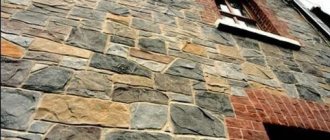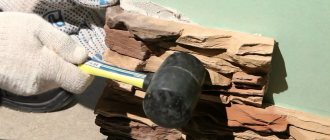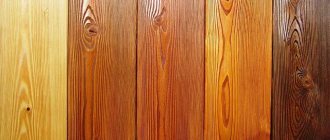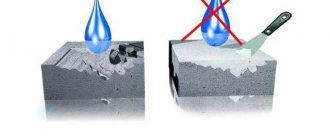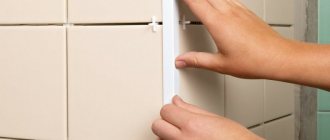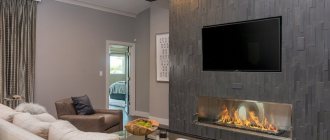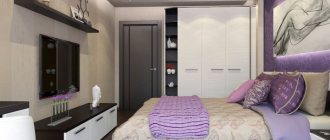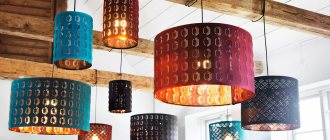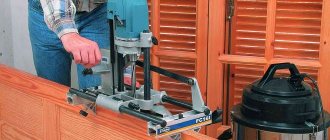Surely, each of us, at least once in our lives, while watching a movie or leafing through a glossy magazine, came across bar counters, accent walls or stone panels equipped with lighting. Natural stone with backlight looks unusual and incredibly luxurious, but, unfortunately, not all stones have the ability to transmit light; such minerals include: onyx, agate, quartz and other semi-precious stones used in interior decoration.
Plaster painting
If desired, gypsum materials can be given a completely unimaginable look, including imitating naturalness (for example, wood).
Various technologies of toning, coloring, and “aging” are used here. Marble tinting. A well-dried gypsum product is impregnated with heated drying oil or shellac-rosin alcohol solution. The impregnation adheres well, without streaks, creating protection against moisture. Gradually the dried primed surface becomes similar to aged marble.
Thanks to tinting, gypsum decor easily imitates marble
Wax tinting. An impregnation is used, consisting of wax dissolved in turpentine (gasoline) with a slight addition of yellow oil paint. After the impregnation dries, the surface is rubbed until glossy.
Ivory-like tinting. A soap maker, nitro varnish and a little yellow oil paint are used. The surface is given a matte finish by rubbing with talcum powder.
Patination. Various shades of brown or brown-green are selected and mixed with other substances. It is recommended to paint in three layers, and in the recesses the treatment is usually carried out with a mixture of a more viscous consistency. The technology of applying the dye is also important here:
- the first layer is lighter, after which it is lightly sanded and wiped with acetone;
- the second layer – the coloring mixture is darker and thicker;
- third layer - to give it a matte finish, a little wax is dissolved in the paint.
The following additives will help to shade or enhance the imitation: bronze powder, talc and chromium oxide, graphite powder, sienna, ocher, umber, soot, green cobalt, lead or zinc white. These are all semi-professional methods of painting gypsum-based materials. Traditional plaster paints are available for sale.
The most commonly used paint mixtures for interior work are acrylic water emulsions or dispersions. After drying, they create a durable protective film that protects the base from moisture. In addition, all water-based paints are environmentally friendly, which means they can be used inside any premises, including residential ones.
When making decorative brick or stone based on gypsum, the working solution is tinted. For this, various powder pigments are used. Tinting the mortar makes it possible to obtain finished bricks that are uniformly colored throughout the entire structure (then operational defects will be less noticeable).
To create an imitation of texture (veins), paints of several shades of color are used. And a finishing varnish coating will help increase the protection of the surface of gypsum brick or stone (after all, gypsum is quite fragile by nature).
Experts advise not to delay painting gypsum finishing elements, as the adhesive properties of the materials deteriorate over time. If this happens, then it’s a good idea to use a primer, and only then paint. The primer will also increase the strength of the gypsum base and create some protection against moisture penetration.
Construction plaster offers unlimited possibilities for original interior decoration. Widespread availability and ease of use have made the material very popular. And having in your arsenal paints, miniums, varnishes, gold leaf and other pigment substances, you can achieve real palace luxury.
Photos of completed projects
Combined room decoration.
Bar counter separating the hallway and the kitchen-living room. Decorative brick was used for cladding.
The decoration of the hallway walls is wallpaper and slate.
Plain wallpaper and slate were used to decorate the kitchen.
The interior color scheme of the hallway matches the colors used in the kitchen.
Cobblestone cladding of part of the bar counter and wall surface. The artificial material is complemented by pistachio-colored wallpaper.
To decorate the apron and column areas in the kitchen, we chose a collection of bricks with different tones.
Highlighting the dining area in the kitchen interior using a brick wall.
Light shades in the design of the kitchen-dining room space.
A palette of pastel colors in the hallway.
Rich colors in the hallway design using figured slate.
Wood, stone, brick, clay are traditional materials for the construction of residential buildings. Having migrated from the exterior to the interior, they are also used for interior decoration. Thanks to the development of technological processes that create all kinds of shades, sizes and textures for decoration, artificial stone in the interior has become a favorite technique of decorators, and various masonry structures have become strong accents that make a living space individual. The use of an artificial analogue of natural stone allows you to maintain the interior of the house in a wide variety of styles, from Empire style, as an imitation of ancient Greek, to any variations of modern minimalism.
How to paint artificial stone?
Painting the material at home is usually necessary when purchasing unprocessed products or making products yourself. In the second option, it is better to provide for painting the gypsum mass. This will allow for surface painting only to highlight the desired areas.
If, when making a stone yourself, you take care of its color in advance by adding color to the gypsum mass, then less effort and time will be spent on the entire coloring process
Painting plaster in general is not very easy; it requires care and a lot of time. In addition, the result when choosing a certain color is not always the desired one. Therefore, it is recommended to test all formulations in advance.
For the front coating, various types of dyes can be used to give the parts the desired shade.
Acrylic paint
The water-based solution is quite popular; it allows you to decorate and protect the surface. This material has a number of properties necessary for artificial stone made from a gypsum mixture:
- Elasticity. Cladding elements are subject to thermal expansion, which can lead to the formation of surface cracks. Due to a little elasticity, this problem will be eliminated.
- Vapor permeability. This parameter is very important for plaster, especially inside the house. The fact is that this material helps create a microclimate in the room by absorbing and releasing moisture.
- Resistance to various types of influences. Of course, paint will not protect parts from strong mechanical influence, but it will protect them from ultraviolet radiation and excess water.
Painting with acrylic paint will add additional protective properties to artificial stone, which is especially important in rooms with temperature changes and high humidity.
If you want to obtain high moisture resistance, purchase a mixture with the addition of silicone. A distinctive feature of acrylic compositions is that they easily change their color; for this, tint is used.
Vitriol
Iron and copper sulfate are used as impregnations. The main purpose of these mixtures is to enhance the strength of parts, but there is also a side effect - coloring. The iron variety gives the stone a yellow tint, and the copper variety gives it a blue tint.
The dry composition is diluted with water in a suitable container, the elements are immersed in the solution for two hours. The main thing is to place the fragments so that they do not touch each other, otherwise stand-out areas will appear.
Vitriol gives the gypsum a beautiful yellow tint, but to achieve a resemblance to natural stone, additional paint is applied to individual sections of the tile.
stain
For gypsum, compositions are mainly used that are also suitable for concrete artificial stones. They are monochromatic mixtures. There is a rich palette of shades, but if necessary, staining is done with wood stain.
There is also an acid stain
It should be handled with great care. Much depends on the composition of the gypsum tiles, so it is recommended to test the mixture on one product
Painting artificial stone with wood stain
Other types of solutions
Painting can be carried out in other varieties that color the surface of the stone:
- Any options intended for gypsum.
- Varnish of various modifications.
- Impregnations. Many of them not only improve product quality, but also affect appearance. For example, a penetrating mixture with a wet effect adds shine to the surface and creates the illusion of moisture.
- Self-prepared compositions. The main thing is the correct selection of components.
Specialized paints that imitate natural stone
Scope of application of flexible stone
Flexible stone is used for:
- Cladding of facades, ground floors.
- Wall decoration in offices and residential premises.
- Decoration of the fireplace area.
- Finishing the work area in the kitchen (kitchen apron).
- Wall decoration in swimming pools, bathrooms, toilets.
- Decoration of stairs and fences in gardens.
- For small decor (lampshades for lamps, for example).
As you can see, the scope of application of this material is very wide, and its demand is also high.
Painting Tips
In order for the painting job to be successful, you must first prepare the necessary materials. You will need:
- Sponge made of rubberized material;
- Sandpaper;
- A piece of cotton fabric;
- Paint sprayer;
- Sanding file;
- Degreasing solution;
- Dye;
- Set of brushes;
- Impregnating suspension;
- Compressor.
Finishing with colored decorative stone is often used in landscape design and facade work, so the choice of paint must be taken especially responsibly.
Painting requires compliance with certain rules:
The stone is dried for 24-48 hours before painting; The old cladding is pre-polished so that the paint does not crumble; Impregnations are used strictly in accordance with the instructions
It is also important to consider the compatibility of impregnations with dyes; To make the surface shiny, you can use a varnish coating. However, it does not always look beautiful, since the effect of the naturalness of the material is lost.
If you follow these tips, the coating will look natural and the paint will last a long time.
Flexible stone in damp areas
The material is not afraid of high humidity, so it is actively used in rooms where this very humidity is in excess: in bathrooms, bathhouses, saunas, swimming pools. The flexibility of the material allows you to paste it over even plumbing fixtures. The color palette does not limit the choice of style.
Using plaster varnish
Standard plaster products are grayish or white, and painting them or tinting them with a colored varnish will help give the wall the desired look. With its help, you can design the surface in an original way and stylize it in accordance with the chosen direction in the interior. Varnishing helps increase moisture resistance, because gypsum products deteriorate when in contact with moisture. After varnishing in several layers, the decorative stone will be suitable even for finishing wet rooms. Also, applying varnish reduces the susceptibility of the tiles to impact.
Varnish for gypsum decorative stone: types
There are varnishes of different types, compositions, with different characteristics and properties on sale.
Shellac varnish
This type is usually used in decoupage, but it is often used in finishing work. Shellac is alcohol-based, so it works well with plaster. It can be applied as a stand-alone coating or over any paint. Shellac creates a thin polishing layer that looks stylish and very attractive.
The composition can be transparent and colored. There are even special varnishes with an aging effect that are used to give the base a vintage look. If you combine the product with rosin in a 1:1 ratio, a protective film will be created on the surface of the plaster, eliminating the appearance of dirt and giving the wall a marble look.
Acrylic varnishes
Acrylic-based varnishes perform a decorative and protective function. They are moisture resistant, do not deteriorate from household chemicals, ultraviolet radiation, temperature changes, dry quickly, and do not have a pungent odor. When thickening, acrylic varnish can simply be diluted with water.
In appearance, acrylic coatings can be matte, semi-matte, or glossy. Matte ones help give the stone the appearance of a natural, rough material. Semi-matte varnishes work in a similar way, only their transparent varieties may leave a slight light coating after drying. Glossy products shine and lead to glare, which must be taken into account when planning the decor in the room.
Oil varnishes
Oil varnishes contain artificial resins and plant extracts. After application to the gypsum stone, a thin film is formed, protecting the material from any external factors and extending its service life. Oil-based varnishes can be transparent or colored, glossy or matte. After this product has dried, the surface of the decorative stone will look a little darker than initially.
Yacht varnishes
The most durable, long-lasting and reliable varnish for stone is considered to be yacht varnish. It has a high degree of water resistance, making it suitable even for handling yachts. Contains solvents, has an unpleasant odor and is more suitable for outdoor use, although after complete drying it ceases to be toxic. For maximum surface protection, yacht varnish is applied in 2 layers.
Varnishing rules
Before applying the coating, you need to make sure that all elements have dried well after priming or protective hydrophobization. The adhesive to which the decorative stone was attached must also dry out, otherwise the integrity of the cladding may be compromised.
Tips for varnishing stone:
- rough parts should be sanded before spraying varnish; fine-grain sandpaper is well suited for this purpose;
- if impregnation was applied to the stone, you need to read the instructions for it and clarify the possibility of subsequent varnishing and compatibility with a particular varnish;
- shiny compositions reduce the effect of the naturalness of the stone, so for country styles, Provence and other styles striving for naturalness, it is better to choose matte products;
- Before varnishing, be sure to wipe off all dust from the stone;
- during work, do not wet the wall or elements - they quickly absorb moisture;
- The most convenient method of varnishing is spraying from a spray gun or airbrush.
By using your imagination, you can use decorative stone to find very interesting solutions even in a small apartment. This material looks unusual, fresh and gives the house a special flavor, fills it with warmth and comfort.
Varnishing rules
Varnishing, like painting, is the final stage of laying tiles. But, if before painting the gypsum stone, the cladding is allowed to dry for 24 hours, then you will have to wait 1-1.5 weeks before varnishing. By this time, the glue will be completely dry, and the fixation will be as reliable as possible. To get the best results, it is useful to use the following tips:
- A water repellent is first applied. It penetrates into the plaster without forming a film, increases moisture resistance, and gives the material antiseptic properties.
Applying varnish to an uneven surface Source zhkpribrezhny.rf
- The varnish is applied with a convenient tool in two steps. The second layer is applied only after the previous one has completely dried.
- Leaks are almost inevitable. After drying, they are carefully cleaned with sandpaper (before applying the second layer).
- If necessary, the varnish layer can be removed with a special solvent; the plaster will not be harmed by this.
- The drying time of each layer depends on the type of varnish and is indicated in the instructions. The lower the temperature, the longer the coating takes to dry.
- After the second layer of yacht varnish has completely dried, the surface can be wiped with a damp cloth to get rid of residual stickiness.
Varnishing improves the aesthetics of the finish Source idei.club
Painting
painting decorative stone
To paint artificial stone, use brushes with a roller or a spray bottle.
In particular, thanks to the spray gun you will save on the consumption of paint and varnish materials, shorten the repair period, the paint will lie much more evenly, it will be easier to adjust the saturation and depth of color, and during the work the entire painting area will be visible at once.
You can also use brushes with a roller, however, the paint consumption will increase several times, and the quality of the work will be slightly lower. However, you will need brushes in any case, for example, for touching up contrasting areas, drawing colored stripes, creating a mosaic panel, simulating veins or inclusions, etc.
So, make sure that the hydrophobic impregnation is completely dry. Let's move on to painting.
To begin with, it is advisable to practice in a small area to check the results of your work. Then apply the paint to small areas of the wall, holding the sprayer 40 cm from the cladding surface. It is better to set the pressure in the tool to 3-3.5 atm. By the way, two sprayers with different shades of dye are often used simultaneously.
But with brushes you can effectively treat each tile separately, showing your creative imagination, for example, strengthening or weakening the desired halftones, drawing veins, stripes, etc. The technology of the work is simple - dip the brush in the composition and paint.
It is worth noting that decorative stone, especially gypsum, usually absorbs paint unevenly across individual tiles. But this is completely natural for him. Such heterogeneity, with an individual pattern for each tile, on the contrary, will make the decorative cladding more similar to natural stone.
In principle, this paint job can be considered complete. After some types of paint, such as acid paints, the base must be thoroughly washed, dried again, and then covered with hydrophobic impregnation.
Wait for the surface to dry and enjoy your updated artificial stone wall.
We wish you a successful renovation!
Tools
The set of tools largely depends on the tasks assigned. If you need to apply varnish to the decor around the doorway, a brush or sponge will suffice. If the amount of work is large, choose a roller or spray gun (airbrush). Spraying varnish for gypsum tiles under brick is convenient at high speed, while the composition is applied evenly, and the shade is the same at all points of the surface.
Avoid fluffy rollers and brushes made from natural materials. They will inevitably leave smudges, and the consumption of paint and varnish composition will be excessively large. Additionally, prepare the following tools and materials:
- Wipes (rags), degreasing solution.
- If you need sanding, you can't do without sandpaper or a sander.
- Impregnation (hydrophobic agent, not always necessary).
For varnishing you can use an airbrush Source ytimg.com
How to paint decorative stone
To make the result of painting the stone pleasing, you must use waterproof acrylic paints. Acid dyes are also suitable as an option - such compositions are able to penetrate deeply into the structure of the decorative stone and resist fading quite well. Another advantage of such dyes is the short drying period.
When purchasing paint, you need to make sure of its high quality. It should not have clots or lumps; any fluctuation in the structure indicates possible problems that need to be eliminated before staining begins.
Using water or a primer, bring the paint consistency to the desired state. In addition to paintwork, you can use plaster varnish - this applies to gypsum stone. After treatment with this composition, gypsum tiles receive a uniform color. The varnish itself is applied evenly, without streaks, dries quickly and does not flow down the surface.
What should be avoided is the use of quick-drying nitro-varnish dyes - after drying, such a composition forms a thin film, which will inevitably flake off when the temperature changes.
The use of quick-drying nitro-lacquer dyes should be avoided.
Another worthy option is a liquid or dry dye that needs to be added to the water. To obtain a solution of the required saturation, mix 1 teaspoon of pigment and 400 ml of water and acrylic primer.
To avoid mistakes, read the instructions that come with the paintwork from the manufacturer.
Tool selection
To determine the list of tools that you need to have available to start work, it is worth assessing the quality of the surface. If the surface is old, then more tools will be required; for new tiles, there may be fewer tools. On average, the list of accessories consists of:
- Vacuum cleaner - necessary for cleaning contaminated surfaces and removing dust;
- Sanding accessories - this can be either a sanding machine or sandpaper;
- Sponges and brushes - necessary for touching up colored elements and hard-to-reach places;
- Spray gun or airbrush.
Flexible stone in the kitchen
There are other uses for this material in the kitchen. What do we expect from a kitchen apron?
- Strength.
- Moisture resistance.
- Insusceptibility to temperature changes.
- So that it does not absorb dirt and odors.
- To be easy to clean.
- To look presentable.
Flexible stone has all these qualities. In addition, it is easy to install and does not deform. A stone apron and stone countertop will give your kitchen an aristocratic look.
Unusual coloring of a plaster product
Painting artificial stone can be a creative process:
Under old marble
We keep it in a dark room for 48 hours.
To get the effect of old marble, you can use the following painting technology:
- We buy plaster facing material;
- We keep it in a dark room for 48 hours;
- We heat the drying oil - to protect your hands, you need to use special gloves;
- We cover the tiles with hot drying oil, using a flat brush, it is better to apply the coating in two layers - we treat the surface evenly, without missing unpainted areas.
When the drying oil dries, the gypsum tile will be covered with colored veins that perfectly imitate antique marble. Such products have found their use in finishing kitchens, fireplaces, and so on.
Creating a bronze sheen
You can also do a bronze tint when painting gypsum tiles yourself:
- To begin with, a layer of heated drying oil is applied to the gypsum products. It will take at least 8-10 hours to dry them;
- Next, you need to make a mixture of bronze powder and varnish - we apply this material to plaster products in 2 layers;
- Leave the material to dry;
- Mix 100 ml of acetic acid and 10 g of silver nitrate in 300 g of water;
- We apply dry bronze powder to dried artificial stones and cover it with a vinegar solution on top - such ingredients on the surface of the facing material trigger an oxidation reaction;
- Gently wipe the finished stones with a piece of velvet.
Stain in combination with gypsum also allows you to get a beautiful surface.
Using stain
Stain in combination with gypsum also allows you to get a beautiful surface. It is good to apply stain with a spray gun, but the best effect is obtained by dipping gypsum products into the solution. The stain needs to be warmed up a little and the plaster is lowered into it for a few seconds. After this, it is enough to dry the facing material to obtain a finish in brown tones.
Whatever you choose, you need to first train in a small area - this will allow you to evaluate the final result and adjust your efforts. The final stage of painting can be washing and drying the products - this is important for acid paints. You can also complete the decor of artificial cladding with hydrophobic impregnation - all you have to do is wait for all the layers to dry and evaluate the result.
Finishing technology and care
Ease of application on surfaces of complex shapes is an important advantage of soft stone; finishing with the material is in many ways reminiscent of the technology of gluing ordinary heavy wallpaper. The work is carried out in compliance with the following simple rules:
- The surface of the wall is carefully leveled: the plastic material can highlight defects.
How to decorate a bathroom Source dekormyhome.ru
- For gluing, special mixtures or glue are used, sometimes tile adhesive (wallpaper does not shrink). Before applying the glue, the wall is primed and allowed to dry.
Tile decoration Source steadicams.ru
- The canvas is glued in compliance with the correct direction of the texture. If the coating is applied to corners or curved surfaces, it is slightly heated with a hair dryer. Elasticity appears, and the fragment takes the desired shape.
- There is a protective film on the front surface of the tile (roll). It is recommended to remove it a day after installation to prevent glue from getting in.
In the interior of the hallway Source i5.photo.2gis.com
Caring for a surface made of flexible stone is not difficult. Dust is removed with a vacuum cleaner with a soft attachment, dirt is cleaned with a brush and water (you can add a little mild detergent). An acidic environment can damage the surface, but in residential areas there is no need to worry about this.
Flexible solution Source realstonegroup.kz
How to paint artificial stone
With such a variety of materials, it is quite difficult to choose what to cover with decorative stone.
The most popular options are:
- acrylic paint;
- vitriol;
- stain;
- various colored solutions.
Each of the materials has application features and properties.
Acrylic paint
Water-based wall paint is popular because it not only allows you to paint walls, but also protects the surface from weather conditions.
Acrylic paint for decorative stone has a number of advantages:
- elasticity. Due to changes in temperature conditions, cracks and deformations can form in the surface. Due to elasticity, this problem is eliminated;
- vapor permeability. This material perfectly absorbs and releases moisture;
- the ability to easily change color by adding color.
- resistance to ultraviolet radiation and moisture.
If you need to increase moisture resistance, you can choose a mixture with the addition of silicone.
Vitriol
Iron and copper sulfate are used as impregnation for walls made of natural stone. Such compositions increase the strength of parts. However, these compounds change the color of the treated surface. Iron sulfate turns the stone yellowish, and copper sulfate turns it blue. If this is exactly what you need for decoration, the elements should be immersed in the solution for a couple of hours in this way. So that they do not touch each other.
stain
Decorative gypsum coating for stone walls is treated with the same compounds as concrete. On sale, these mixtures are monochromatic, but if you want to diversify the palette, you can use wood stain. Acid stain is popular, but you should try the treatment on one plate before applying to all walls.
This is important, since gypsum stones can vary in composition
Other types of solutions
There are other options for solutions that can be used for coloring
When choosing what to paint the surface of walls to look like stone, you can pay attention to the following materials:
- varnishes;
- impregnations that can not only color the surface, but also improve their quality. Wet effect mixtures can create a shiny film on the stone and create the visual illusion of moisture on the wall;
- paints for plaster of any modification;
- compositions created with your own hands. In this case, the main thing is to choose the components wisely.
Compositions that can imitate natural stone have appeared on the building materials market. However, their cost is not yet available to everyone.
Application: for external cladding not only
Flexible stone is one of the best materials for decoration. It attracts designers with a variety of installation techniques, a wide color palette and a large selection of patterns. Therefore, the stone is used to implement a wide range of tasks, the most popular ones are presented below.
Cladding of internal walls in premises for various (almost any) purposes . The walls of the large hall of the house look attractive. Easy to maintain and easy to clean, the stone can be used in a children's room. Flexible products are an excellent solution for the bathroom. They will look spectacular in the living room and hallway of a house, cottage, or apartment.
Wall cladding with flexible stone Classic-1. Photo PC Flexible Stone
Floor covering. Flexible stone can successfully replace tiles for flooring. The coating can withstand significant mechanical loads, so it is suitable for decorating floors in the bathroom, hallway, and kitchen. Stone floors look great in classic interiors. The ideal environment for flexible stone is Art Deco style.
Ceiling cladding. Flexible stone also looks great on the ceiling. The ability to give the material any bend allows the stone to be used for surfaces of various configurations. For finishing the ceiling, the optimal solution would be flexible tiles of medium thickness.
Covering the fireplace area. Any fireplace or its imitation requires finishing. The fireplace area, regardless of location: living room or bedroom, looks best in its original form, i.e. made of stone, even from its analogue. Flexible stone is suitable for decorating real and electric fireplaces . A particularly successful solution is the cladding of an electric fireplace. Since in this case a special niche is set up , it is most often made from plasterboard (gypsum is the basis for the production of not only plasterboard, but also gypsum stone). GCRs are subsequently decorated with various materials, which have one important requirement - low weight. Drywall is not able to support the weight of natural materials, so flexible stone is the best option. Beautiful and functional decoration of the fireplace area is provided.
Cladding the fireplace area with flexible stone Coffee-1. Photo PC Flexible Stone
Cladding of columns. This element does not go out of fashion and is actively used for interior decoration. Square-shaped columns can be decorated with various materials depending on preferences. But there are not many options for finishing round columns: painting, decorative plaster and flexible stone. The possibility of installation without joints makes the cladding attractive and natural.
Arch cladding. Decorating arches with decorative stone is a popular solution. An arch is an architectural element with which a small room can be visually made larger and a spacious room can be effectively zoned. A well-decorated passage saves and expands the room, separates adjacent rooms, creates a unified design and style, and creates the necessary atmosphere.
Cladding of steps. One of the main areas of use of stone is the finishing of steps and flights of stairs.
Partial cladding. The high cost of flexible stone requires significant costs for cladding large areas. Therefore, it is possible to carry out partial cladding of the premises. In the kitchen, stone is used to cover the work area. The durable and easy-to-maintain coating acts as a kitchen apron. Flexible stone in this case is an interesting alternative to tiles. In the bathroom, stone is used to decorate the shower stall.
Attention! The stone is suitable for any room, but there is no need to go overboard with decoration. It is not recommended to decorate the floor, walls, and ceiling with stone at the same time. It is better to choose one area for cladding. Only in this case will the design of the room look organic.
Internal cladding made of flexible stone looks presentable not only in residential premises, but in public places: retail premises, offices, recreation areas, swimming pools, water parks. Flexible panels are suitable for cladding the facades of buildings for various purposes: private houses, cottages, bathhouses and other residential buildings, commercial, state, municipal, and administrative buildings.
Cladding the facade of the house with flexible stone Emerald-3. Photo PC Flexible Stone
Flexible stone can be used for cladding facades and plinths, fences and other barrier structures, architectural and landscape elements.
Buy or make it yourself?
Manufacturers have developed many types of finishing materials. Gypsum bricks for interior decoration are presented in various modifications in catalogs:
- The glossy varnished version is fashionable.
- The matte muted look, which is treated with a protective compound, is interesting.
- Models with a flat surface, embossed or curved are equally in demand.
There are gypsum blocks on sale that replicate hewn stone segments or irregularly shaped minerals, but the easiest to use is an imitation of brickwork.
The entire spectrum of beige colors, shades of gray, brown, and sand are in demand. Many consumers prefer the color of natural brick or simple white. A colorless surface can be painted with selected paint. To the touch, decorative gypsum material can be smooth, structured or rough.
If desired, a home craftsman can make a lightweight and stable stylized brick himself. This process is quite labor-intensive and requires strict adherence to the recipe and the availability of suitable containers for filling the composition. Experts advise using commercially available silicone molds.
The main ingredients for creating such a finishing material will be: gypsum itself and PVA construction adhesive. If desired, a decorative color or pigment can be used; a white version can be formed. To prepare a solution of the required consistency, water is added when mixing the components.
For 1 kg of dry powder you will need approximately 0.5 liters of liquid and about 50 g of PVA. You can add polypropylene fiber for reinforcement: you will need 1-2 g of it per kilogram of gypsum base.
The required amount of dry matter is gradually poured into the container, water and glue are also added gradually. The resulting “dough” is stirred until smooth, resulting in a composition reminiscent of 25% sour cream.
To stimulate the setting process, some craftsmen add citric acid to the solution: about 0.5 g per standard bucket. The coloring pigment is first diluted in water and added to the total mass at the end of the preparation process.
The molds can be greased with petroleum jelly or treated with soapy water. The mixture is poured in one layer and after half an hour the decorative “masterpiece” becomes solid. It is recommended to coat finished products with an acrylic primer.
Briefly about the main thing
Gypsum is used to make beautiful and practical finishing materials - gypsum tiles and decorative stone. In order to maintain their attractiveness and improve their performance and decorative properties, varnishing with various compositions is used.
To create a protective layer, oil, acrylic and yacht varnishes are used. The desired composition is selected according to personal preferences: shade, reflectivity and other characteristics. Two layers of varnish are applied to the cladding, trying not to leave smudges. Before work, you need to prepare the necessary tools and study the instructions for applying paintwork.
Ratings 0
Coloring option
In bulk
It is considered the most practical and best way. In this case, coloring pigments in powder form, which are used for concrete, are added directly to the gypsum solution. Thus, you receive a product that is painted from the inside. When cutting or chipping, you will not see the white base.
A beige or yellow solution is best, and in polyurethane form, parts of the stones can be painted with liquid pigments using a brush.
For this:
- take ½ tsp. color (pigment);
- add 200 ml of water;
- add 200 ml of any acrylic primer.
When the stone has set, remove it from the mold and dry it, and after laying it on the surface, apply a matte water-based varnish to it.
This option for painting decorative gypsum stone is the most effective and almost all manufacturers use it. That’s why we can see these kinds of products in stores. The disadvantage of this method is the rough and unnatural painting, which can be observed at close range.
By making gypsum artificial stone yourself, you have the opportunity to work on naturalness by carefully painting parts of the stones in the mold. Of course, no one will do this on an industrial scale, otherwise the price will increase significantly.
Below we will propose another painting technology that will help make a product from gypsum tiles that is more similar to natural stone. You will learn how to paint artificial stone so that it has the same natural veining and color scheme as natural stone.
Surface
Prepare:
- water-based (coloring pigment);
- water;
- spray or brush.
The instructions are simple - you need:
- add a coloring pigment to the water, you can even add several at once;
- dip a brush into the solution;
- saturate gypsum tiles with it.
Artificial gypsum stone has unique properties of developing shades that are similar to natural ones due to the absorption of tinted water.
In order to give gypsum stone the desired shade and color, you do not need to have an artistic education. Dip the brush into the colored water and paint the stone as you see fit.
Then you can tint some with a dark solution consisting of color pigment and water. You shouldn’t think too much about the palette, since each gypsum tile, even with the same texture, will absorb the solution differently, which will allow you to create an individual pattern each time.
You can also use any sprayers for work, for example:
- spray gun;
- sprayer for glass cleaning products.
Pour paint diluted with water-based tinting paste into a container and spray it onto the gypsum tiles. It is better to use several of these sprayers with different colors in your work so that you can treat different places on the stone. Then the painting process will be better and faster.
The advantage of painting yourself
- The store offers artificial stone in standard colors and with obvious artificial coloring. It does not have natural colored veins, like natural ones.
- You can purchase products in white or plain beige, glue them to the walls, and then paint them on the spot with water and coloring pigments diluted in it. This method makes masonry much more natural. (See also article.)
- Once the plaster stone has dried and become faded and pale in appearance, open it with any silky matte or matte varnish. This way you can restore the color saturation of the product, strengthen and protect its surface.
- If you want to achieve a “wet” effect on artificial stone, use varnishes, but be aware that this will slightly reduce the naturalness of the material.
How does it look in different rooms?
In bathrooms, if the budget allows, flexible stone is used to completely finish the walls and floors. If you don't want a stone room, combine flexible stone with paint, mosaic or wallpaper (in dry areas).
In the kitchen, a stone apron is most often made: it is not afraid of high temperatures, is easy to wash off grease, and looks impressive. To prevent the area above the work surface from looking too tacky, highlight the dining area with flexible stone.
In living rooms they make entire figurative compositions: you can depict mountains or any abstract figure. They are mainly used as a background for a TV or to decorate the surface behind the sofa.
The photo shows stone walls in the living room
Stone on the walls looks no less impressive in a study: it gives solidity and seriousness to the owner of the room and emphasizes good taste.
You can veneer niches or partitions. For example, use a niche for video equipment mounted to hide the wires.
Painting in bulk
There is nothing easier than painting artificial stone using this method. We take the pigment, dissolve it in water, then add plaster and make a solution. Then pour it into the molds.
Pros:
- Fast painting method;
- All tiles are painted (inside and outside);
- No fading.
Cons: You can only get 1 color.
After drying the stone, the color will fade, so only testing can determine the final color of the stone. I mixed 1 kg of gypsum and added different amounts of pigment: 3, 6, 10, 15 grams. The main thing is to write everything down so that you don’t forget later how much pigment you added to which stone.
If you want to thank me for sharing my experience with you, then write a comment on this article with any question or suggestion. Perhaps from your comment I will get a topic for one of the future articles. Write a comment
Ceiling decoration with flexible stone
We laid the tiles on the floor, but they can be laid on the ceiling in the same way. This is a truly flexible material, so you can make a ceiling of any configuration. A variety of colors gives room to the imagination and allows you to choose the right tone for any interior style.
Methods of painting gypsum products, materials for tinting, tools
Gypsum has excellent adhesion to a wide variety of paints and varnishes; there are many ways to paint it:
Colored solution for painting gypsum products
Let's consider how to paint a decorative gypsum stone. Painting gypsum stucco can be done with various compositions:
- acrylic;
- water-emulsion;
- pentaphthalic;
- limestone;
- silicate;
- silicone;
- latex.
When choosing how to paint plaster stucco molding, focus on the desired texture:
acrylic paints and varnishes give a satin finish, water-emulsion paints give a matte finish, pentaphthalic compositions are glossy and do not require varnish. Silicate, silicone and latex compositions have a rich range of colors, many interesting textures - stone, velvet, velor, Venetian, they form a moisture-resistant film on the surface of the stone, but their cost is much higher than that of acrylic and emulsion ones.
Most often, acrylic, lime and water-emulsion compositions are used, as they are more economical. The easiest way to achieve a metallic effect is to use car paints in aerosol packaging. To obtain some types of textures, natural drying oil is required. If you do not plan to frequently change the color scheme of the interior, then paint and varnish materials should be chosen with a service life of at least 10 years. To increase the adhesion and strength of the product, you can add up to 5% of the volume of PVA glue to the paint.
Copper or iron sulfate is used as an impregnation for gypsum. Copper gives plaster a blue tint, iron gives it a yellowish tint. To paint, tiles or decorative fragments are immersed in an aqueous solution of vitriol for 2 hours, while the parts should not touch, otherwise spots of different shades will appear on the surface.
When varnishing finished products, carefully choose the composition: a varnish with a strong gloss can look kitsch in some interiors due to its shine, so it is better to choose a matte or low-gloss finish.
In addition to the spray gun, brushes are used in the work - flat fluted and paneled, with a rounded end, with soft or hard bristles. The hair of the panel brushes is kolinsky, squirrel or badger, fluffy. For shading and texturing, use brushes with hard bristles and French knit bristles.
Tampers made of rags and foam rubber also help to shade the boundaries of the color; they are made manually from materials that are found in every home: most often by tying a piece of sponge or fabric to a wooden stick and wrapping it with thread or wire.
Painting stucco molding with small relief details at a height requires the construction of a scaffold so that all unpainted areas are visible and do not strain your hands.
Manufacturing technology
Not only the characteristics of flexible stone are special, but also its production technology. It is made in the place of extraction of natural material - stone. Only harmonious sandstone cuts with a beautiful expressive pattern are suitable for its production. Next, this cut is ground until the surface is smooth.
Extraction of flexible stone in a quarry
The basis is textile material, which is coated with acrylic dispersion plasticizers, and the cut itself is attached to it. After some time, the textile material is removed, and the remaining section with an adhesive base is dried in the sun. Thus, the sandstone particles are tightly glued to the canvas, and the pattern remains unchanged.
Return to content
How to paint
Before painting a gypsum stone, care must be taken to reduce its hygroscopicity. To do this, it must be endowed with a water-repellent effect. This can be done using special compounds. At the same time, the vapor permeability of the material is not affected. You can find a ready-made solution in hardware stores or dilute it yourself from concentrates. By the time of application, the gypsum stone should already be thoroughly dry. It is necessary to remove dust from it. The composition is applied using a brush or spray gun.
Lucky
The following types of varnishes can be used to coat gypsum stone:
- acrylic;
- oil;
- yacht
Acrylic varnish is water-based. It contains various resins. The consistency is similar to thick milk. It can be used for interior and exterior decoration. Most often, such varnish provides a finishing coat that will protect the base layer. It creates a special film on the stone that has a water-repellent effect. It also protects against exposure to ultraviolet rays. The dried surface is easy to clean using various products. Available in glossy, semi-matte and matte varnish. Each of them has its own unique effect. Glossy varnish gives gloss to gypsum stone
When using it, it is important to maintain moderation, because
the surface will strongly reflect light, which can spoil the idea. Matte varnish on gypsum stone looks solid. It creates an atmosphere of comfort and peace.
Oil-based varnish can be used with the same success for gypsum stone. It provides excellent protection to the cladding due to the fact that before complete drying a film is formed, which remains after drying. It increases resistance to mechanical stress. To achieve the required consistency, special solvents are used. In terms of surface matte level, oil varnish has the same properties as the previous type. It is worth considering that this varnish may darken a little after drying.
Yacht varnish will provide the most protection for gypsum cladding. It must be applied in a thin layer to avoid drips, which will be difficult to get rid of later. It dries in about a day. This period may be extended due to low temperature or high humidity. After drying, another layer is applied. In some places, you may need to sand the surface with fine sandpaper to remove drips.
Paints
Painting plaster cladding is easier than it might seem. One option would be to add pigment to a water-based varnish. You can use water-based paint with the addition of any pigment. There are special pigments that are diluted with water. Gypsum will perfectly absorb the coloring base. In this case, you don’t have to try hard to draw lines. The manufacturer often colors the gypsum cladding himself by adding dye to the base. A video about painting gypsum stone can be seen below.
https://youtube.com/watch?v=BCqKYGOlK0k
Decorating arches and columns with flexible stone
It is good to use flexible stone to decorate interior arches. It is beautiful and durable, does not weigh down the interior. In this case, the arch can be of any shape - straight, semicircular, figured - the material, as already mentioned, is very plastic. If you have an arch with columns, then cover them with flexible stone as well.
What paint should I use to coat gypsum tiles?
At home, you can carry out surface painting of gypsum bricks. For painting the following are used :
- Acrylic paint for plaster . You can buy it ready-made at a hardware store or paint it yourself. Together with a primer and water repellent, acrylic paint reliably protects against fungus, mold, and reduces water absorption.
- Silicate and silicone for painting external walls . It is based on liquid glass and silicone resins. It is characterized by the durability of the coating, service life is about 20 years.
- Water-soluble varnishes for matte or glossy surfaces. Varnishes provide reliable protection of the stone from abrasion.
After treating the surface with varnish, its original shade will become noticeably darker.
Read more about how to paint a plaster wall here.
How to cover decorative brick in an apartment?
In modern construction, artificial stone is widely used both for interior decoration and for external cladding of facades. This material looks very similar to natural stone and at the same time has many advantages.
Preparing the area and material for work:
Before laying gypsum tiles on the wall with your own hands, follow a number of steps:
- Clean the surface of the wall or other area from traces of previous decor and level it.
- Prime the wall with impregnation. It is also advisable to prime the stone itself. The primer will help reduce the absorption of the inner surface of the stone and remove dust. Let the primer dry.
- Start laying gypsum tiles by laying out several rows on the floor. Based on the resulting pattern, make markings and cut off the required pieces. Perform pruning with a hacksaw or grinder.
Surface markings:
To achieve perfect evenness of the masonry, use a building level or an electronic level. Don't forget to leave room for baseboards, floor coverings, etc.
Choosing adhesive for gypsum tiles:
The choice of adhesive for gypsum tiles depends on the installation method:
- With the seamless laying method, liquid nails, silicone sealant, polyurethane foam or other contact adhesives are applied pointwise in the middle of the tile.
- When laying decorative tiles under brick under jointing, use special gypsum glue or polymer putty, which are evenly applied to the entire surface to be decorated and to the tile.
- It is not advisable to use cement mortar. It takes longer to dry and during this time the plaster absorbs excess moisture. If you still use this glue, then you definitely need a priming step for high-quality installation.
Rules and subtleties of the gluing process:
Decide in what order you will lay the stone. If the stone is of different sizes, alternate large, medium and small tiles. In the second row, change the order. If the stone is the same size, then to start the second row, part of the stone needs to be sawed off with a hacksaw so that the seams of the top row do not coincide with the bottom.
In order for the corner to look beautiful, the tiles need to be cut using a miter box and a hacksaw at an angle of 45 degrees. Wall tiles are glued mainly horizontally. Gluing is done both from above and from below. Work starts from the corner. The edge of the furniture adjacent to the installation site is covered with masking tape. It is removed in small parts immediately after gluing two or three tiles, until the glue has dried. The nuances of installation depend on the chosen method:
- Seamless masonry. Before gluing gypsum tiles to the wall using this method, you need to check its geometry. Sometimes the dimensions of the parts differ from each other. In this case, the middle of the wall is laid out as perfectly as possible. After all, she is the one who always comes into view.
- Masonry for jointing without filling the seam. Often the seams are not filled, since gluing gypsum bricks to the wall using this method is cheaper and faster. The main difficulty is to apply the adhesive very evenly and thinly to the wall. Use a spatula without teeth for this. If the glue comes out from under the tiles, spread it evenly along the seam with a wet brush.
- Masonry for jointing with joint filling. The seam is filled with a mounting gun or a special bag for unstitching.
- To fill the joints, use a special grout for gypsum brick tiles. Dilute the powder according to the instructions, place it in a cone bag and fill all the seams. The width of the opening in the bag is less than or equal to the width of the seam. After application, leave to dry to the consistency of softened plasticine. Then use a special spatula to remove the excess. A relief characteristic of such masonry should be formed. After drying, clean the tiles with a medium-hard brush to remove grout residue. Treat the entire lined surface with polyurethane or acrylic varnish, or any moisture-repellent agent to create reliable waterproofing protection and ensure long-term operation.

